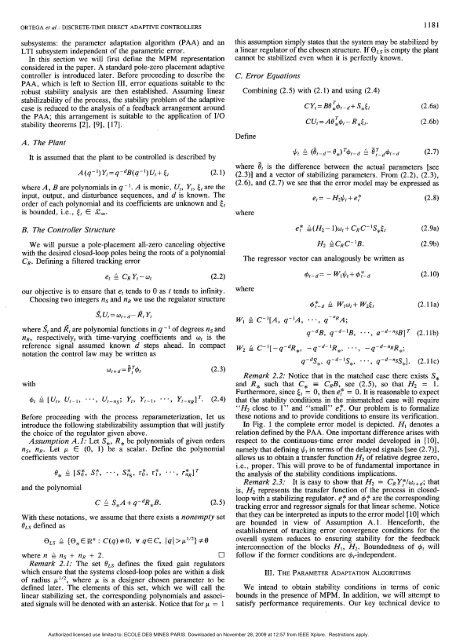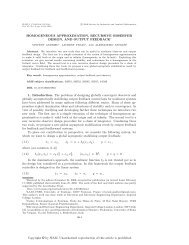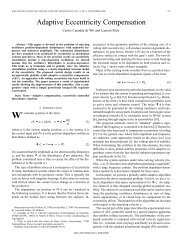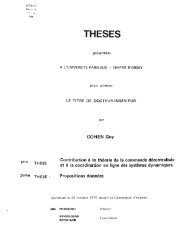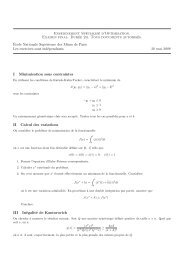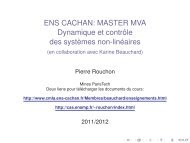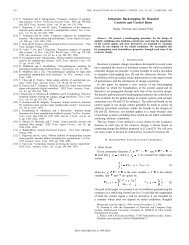Robustness of Discrete-Time Direct Adaptive Controllers - Centre ...
Robustness of Discrete-Time Direct Adaptive Controllers - Centre ...
Robustness of Discrete-Time Direct Adaptive Controllers - Centre ...
You also want an ePaper? Increase the reach of your titles
YUMPU automatically turns print PDFs into web optimized ePapers that Google loves.
ORTEGA et ai.: DISCRETE-TIME DIRECT ADAPTIVE CONTROLLERS 1181subsystems: the parameter adaptation algorithm (PAA) and an this assumption simply states that the system may be stabilized byLTI subsystem independent <strong>of</strong> the parametric error.a linear regulator <strong>of</strong> the chosen structure. If eLS is empty the plantIn this section we will first define the MPM representation cannot be stabilized even when it is perfectly known.considered in the paper. A standard pole-zero placement adaptivecontroller is introduced later. Before proceeding to describe thePAA, which is left to Section 111, error equations suitable to therobust stability analysis are then established. Assuming linearstabilizability <strong>of</strong> the process, the stability problem <strong>of</strong> the adaptivecase is reduced to the analysis <strong>of</strong> a feedback arrangement aroundthe PAA; this arrangement is suitable to the application <strong>of</strong> I/Ostability theorems [2], [9], [17].C. Error EquationsCombining (2.5) with (2.1) and using (2.4)CYl=B6~@,-d+S,~,CUr=A0:4,-R.Jf.(2.6a)(2.6b)A. The PlantIt is assumed that the plant to be controlled is described byA(q-1)Y,=q-dB(q-1)U,+5, (2.1)where A, B are polynomials in q - I. A is monic, U,, Y,, 4, are theinput, output, and disturbance sequences: and d is known. Theorder <strong>of</strong> each polynomial and its coefficients are unknown and 5,is bounded, i.e., 6, E a,.Define$1 2 ($z-d-e.+)T4[-d 2 8T-dbl-d (2.7)where 8, is the difference behveen the actual parameters [see(2.3)] and a vector <strong>of</strong> stabilizing parameters. From (2.2), (2.3),(2.6), and (2.7) we see that the error model may be expressed aswheree,= -ki2+,+e; (2.8)B. The Controller StructureWe will pursue a pole-placement all-zero canceling objectivewith the desired closed-loop poles being the roots <strong>of</strong> a polynomialCR. Defining a filtered tracking errore, 4 C, Y, - w, (2.2)our objective is to ensure that e, tends to 0 as t tends to infinity.Choosing two integers ns and nR we use the regulator structure~~uu,=Wy;d-ff(Yfwhere 9, and R , are polynomial functions in q <strong>of</strong> degrees ns andnR, respectively, with time-varying coefficients and <strong>of</strong> is thereference signal assumed known d steps ahead. In compactnotation the control law may be written aswithWt+d=e:@f (2.3)61 & [Ut, Ut-,, Ur-ns; Yr, Yr-19 Yr-nRIT- (2.4)Before proceeding with the process reparameterization, let usintroduce the following stabilizability assumption that will justifythe choice <strong>of</strong> the regulator given above.Assumption A.1: Let S,, R, be polynomials <strong>of</strong> given ordersns, nR. Let p E (0, 1) be a scalar. Define the polynomialcoefficients vectorand the polynomial0 2 [so*, ST, .e., sfs,rg, r:,*- 9 ‘;RlTC 4 S,A +q-dR,B. (2.5)With these notations, we assume that there exists a nonempty setBLS defined aseLs 6 {e,Ew : c(q)#o, v qEC, lql>pliz)#Owhere n A ns + nR + 2. 0Remark 2.1: The set OLs defines the fixed gain regulatorswhich ensure that the systems closed-loop poles are within a disk<strong>of</strong> radius p where p is a designer chosen parameter to bedefined later. The elements <strong>of</strong> this set, which we will call thelinear stabilizing set, the corresponding polynomials and associatedsignals will be denoted with an asterisk. Notice that for p = 1e: 2 (Hz - l)w, + CR C-lS,,$, (2.9a)H2 gCRC-IB.The regressor vector can analogously be written aswherew, p c-’ [A, q-’A, e..,(2.9b)dr-d= - WI$r++:-d (2.10)6F-d 4 wlw,+ Wz(1qpA;(2.11a)q-dB, qd-’B, . . ., a-d-nsB] (2.1 lb)w2 2 C-l[-q- dR*, _q-d-lR *’ . . . , -q-d-n~R,;q-dS,, q-d-lS,,-.., q-d-”SS*]. (2.11c)Remark 2.2: Notice that in the matched case there exists S,and R, such that C, = CRB, see (2.5), so that H2 = 1.Furthermore, since E, = 0, then e:‘ = 0. It is reasonable to expectthat the stability conditions in the mismatched case will require“Hz close to 1” and “small” e,*. Our problem is to formalizethese notions and to provide conditions to ensure its verification.In Fig. 1 the complete error model is depicted. HI denotes arelation defined by the PAA. One important difference arises withrespect to the continuous-time error model developed in [lo],namely that defining $, in terms <strong>of</strong> the delayed signals [see (2.7)],allows us to obtain a transfer function Hz <strong>of</strong> relative degree zero,i.e., proper. This will prove to be <strong>of</strong> fundamental importance inthe analysis <strong>of</strong> the stability conditions implications.Remark 2.3: It is easy to show that H2 = c~y;/~,+d; thatis, H2 represents the transfer function <strong>of</strong> the process in closedloopwith a stabilizing regulator. e; and q5; are the correspondingtracking error and regressor signals for that linear scheme. Noticethat they can be interpreted as inputs to the error model [ 101 whichare bounded in view <strong>of</strong> Assumption A.l. Henceforth, theestablishment <strong>of</strong> tracking error convergence conditions for theoverall system reduces to ensuring stability for the feedbackinterconnection <strong>of</strong> the blocks HI, Hz. Boundedness <strong>of</strong> @, willfollow if the former conditions are +,-independent.III. THE PARAMETER ADAPTATION ALGORITHMSWe intend to obtain stability conditions in terms <strong>of</strong> conicbounds in the presence <strong>of</strong> MPM. In addition, we will attempt tosatisfy performance requirements. Our key technical device toAuthorized licensed use limited to: ECOLE DES MINES PARIS. Downloaded on November 28, 2009 at 12:57 from IEEE Xplore. Restrictions apply.


